New River Campaign
May 10 - 23, 1862
Giles Courthouse, Princeton, and Lewisburg
In the winter of 1861-62, Union General William Rosecrans
created a plan along with President Lincoln to capture Southwestern Virginia,
with its salt works and lead mines, as part of a grand and unworkable plan to
"liberate" the Unionists of East Tennessee. John C. Fremont took command
of the Mountain District in early 1862 and was charged with executing the plan. Jacob
D. Cox's division would advance up the New River to strike the vulnerable Virginia and
Tennessee Railroad bridge at Central Depot. George Crook would advance through
Lewisburg to the Virginia and Tennessee Railroad near Salem. These
troops would link up with Yankees under James Garfield near the Big
Sandy River in eastern Kentucky along with the rest of Fremont's men, who were to advance
from the mountains to
Staunton in the Shenandoah Valley. The whole force was to move into
East Tennessee.
Cox's two brigades began their
march south from Fayetteville in April and successfully clashed with
Confederates at the Clark House north of Princeton on May 1st. Pursuing
vigorously, the Yankees entered Princeton that day, finding the town in flames.
This was done in order to deny the invaders the supplies stored there, and was
on the orders of Col. Jenifer of the 8th Va. Cavalry, which fell back toward
Wytheville. Although a controversial decision, the burning probably prevented the
Yankees from remaining long in the area. For over a week,
along with some sugar, coffee, beans, and rice, the Union
troops' rations included only one cracker.
 |
| 1862 Union Plan for the Conquest of
Western Virginia
The lead mines were near Wytheville, and not surprisingly, the salt works
were at Saltville. Jeffersonville is now Tazewell, Giles CH is now Pearisburg, and the
Narrows are just north of town where the New River cuts through the
mountains. Central Depot is now Radford. Raleigh CH is now
Beckley. Modern Roanoke is just east of Salem, and although the
state boundary is shown, West Virginia did not yet exist. |
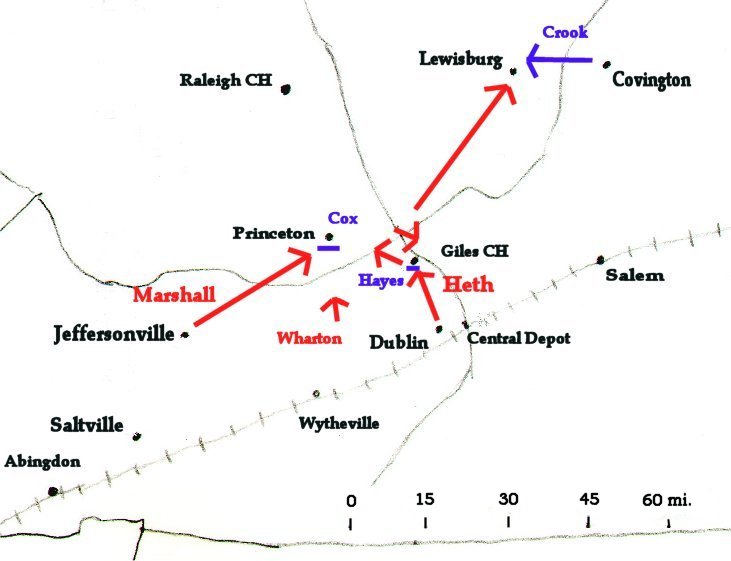
Confederate Response and Campaign Summary
Southwest Virginia was weakly held after John Floyd and
his brigade were transferred to Fort Donelson, Tennessee not long after Carnifix Ferry.
Col. Gabriel Wharton's 800 man 51st Virginia was at Wytheville, and a 1,500 man brigade under Henry Heth
was at Dublin near the New River. When Col. Rutherford B Hayes advanced his Ohio regiment
through the Narrows of the New River and camped at Giles Courthouse, Heth
attacked and routed the Union force.
Assistance was on the way. After Gen. Marshall in Abingdon was no longer bothered by Garfield
along the Big Sandy, he advanced with his 2,000 man brigade from Abingdon and
Jeffersonville toward Cox's lines of communication, forcing
him back to Princeton. He had planned for Wharton and Heth to join him in converging on
Princeton, bringing overwhelming strength on Cox at Princeton and hopefully cutting
off his retreat. Wharton was late, however, and Heth turned back after receiving a
false report of Union victory, but after a small skirmish at Princeton, Cox
would withdraw to Raleigh CH.
Crook's column was now vulnerable and withdrew to the west side of
Lewisburg after hearing the bad news from the New River
and from Fremont's column, which had turned back after a clash at
McDowell. Heth, reinforced with the remnants of Floyd's men from Fort Donelson,
moved northeast to block Crook's line of retreat, and narrowly missed doing just
that. Heth then faced Crook across the streets of Lewisburg.
Let's take a look at these fights individually.
Giles Court House
May 10, 1862

From
Rear of the Union Position (as seen here through the Christmas tree sap
encrusted rear window of a Ford F-150)
On May 6th, future President Rutherford B. Hayes took his
23rd Ohio regiment forward from Princeton through the formidable, but as of yet undefended,
Narrows of the New River, and encamped just beyond Giles Courthouse, now
Pearisburg. Twenty three miles from the main body at Princeton, the
important railroad bridge at Central Depot, defended by Henry Heth, was around
twenty miles away.
Hayes had placed his 600 man command south of town on this
ridge, an extension off the much larger Angel Rest Mountain on the right of the
picture. The Union force was made of nine companies of Hayes' 23rd Ohio to the right of the road, and some cavalry on the left.
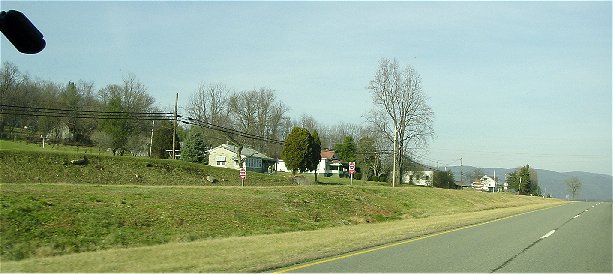
Confederate Attack
This is the view from near Hayes' line, probably from just in
front of it. Heth's 1,800 men approached Hayes along this road early on May 10th and
bombarded the Union position, to which the artillery-less Federals had no
response. The Confederate infantry approached to with 150 yards and began
firing, which was enough to convince the 2nd (W)Va. Cavalry to flee.
Flanked on both sides, Hayes fell back to another position. Col. George
Patton of the 22nd Va., an ancestor to a more famous man of the same name, was wounded as the Confederates routed the Yankees from
this later position, and the Northerners
unsuccessfully tried to burn a bridge behind them.
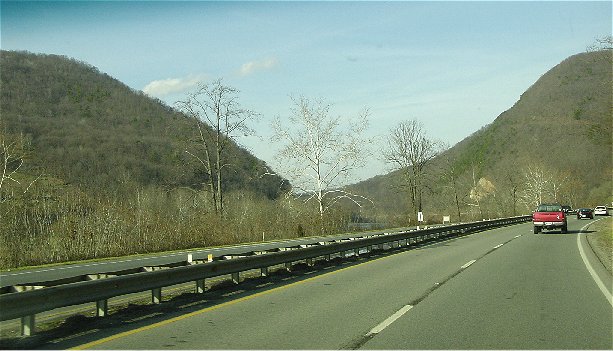
Narrows
The Narrows, with barely enough room for a road between the
mountain and the New River, was the next logical place for the Yankees to make a
stand. But when Heth brought up some guns, Hayes was wounded, and the
Federals fell back again.
At the cost of 2 killed and 4 wounded, Heth had inflicted 20
killed and 50 wounded on the Federals. Cox's advance was stopped, and now
the Confederates plotted his destruction.
Princeton
May 16-17, 1862
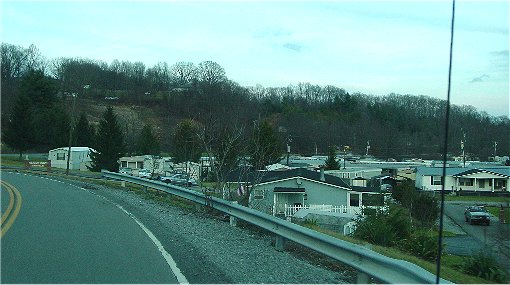
Front of
Confederate Position
The Confederates were converging on Princeton. So while
sending the 37th Ohio south to screen Wharton's advance, Cox moved to strike
Heth first. But when on the afternoon of May 16th Marshall clashed with
Union forces four miles west of Princeton, Cox began to fall back to Princeton
to protect his line of retreat.
That evening, Cox still only had 1,000 men in Princeton to Marshall's 2,000,
which had arrived on the heights south of town, but
since Wharton was expected to arrive the next morning, Marshall decided against
attacking. Instead, he remained on this series of hills, called
Buzzard's Roost. That night Cox withdrew - but then changed his mind and
returned to Princeton! Artillery bombardments and skirmishing started that
morning, but little else happened.

From Confederate Rear - The Ambush of the Drunken Germans
South of town, Wharton's 51st Va had somehow gotten ahead of the
37th Ohio, and for some reason left a wagon of medicinal whiskey behind.
The 51st Va. took up position on Marshall's right flank facing Princeton, on the
ridge on the left half of the picture facing toward the distance. Modern Rt. 460 shown here roughly
parallels a wartime road along the edge of the ridge on the left.
At around 10 in the morning, a heavily "medicated" 37th Ohio,
a unit of mostly Germans, came loudly marching down the road toward
Princeton. Well warned, the 51st Va. shifted positions down to a fence by
the road, ambushing and routing the Yankees, who then found a less direct route
into town. They had suffered 14 killed and 46 wounded.
Although Wharton had arrived, because he believed a false
report of Confederate defeat at Princeton, Heth never did get to Princeton. So Marshall
never attacked, and Cox withdrew north to safety that night.
Lewisburg
May 23, 1862
Cox's withdrawal from Princeton left Crook's isolated column
vulnerable. Crook and his Yankee brigade had
advanced beyond Lewisburg toward Covington, but withdrew to the west side of
town after hearing the bad news from the New River
and of Fremont's McDowell failure at the hands of Stonewall Jackson. Heth had been reinforced by the remnants of Floyd's men from Fort Donelson,
and he now moved northeast to block Crook's line of retreat. Heth just missed cutting off
Crook and faced him across the streets of Lewisburg.
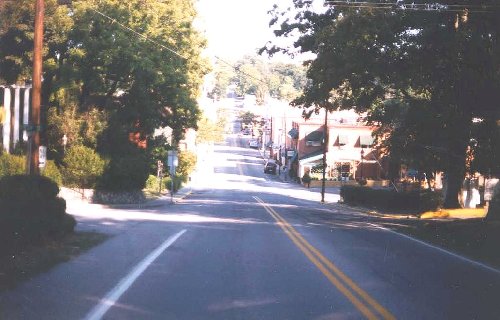
From Union Side
Early on the morning of May 23rd, Heth's men moved through
the town across this valley with their center based on modern Route 60 or
Washington Street. Crook's men flanked the attacking Confederates and
pushed them back across town.

General Lewis Inn
The modern site of the General Lewis Inn was about the
center of the Confederate defensive line.
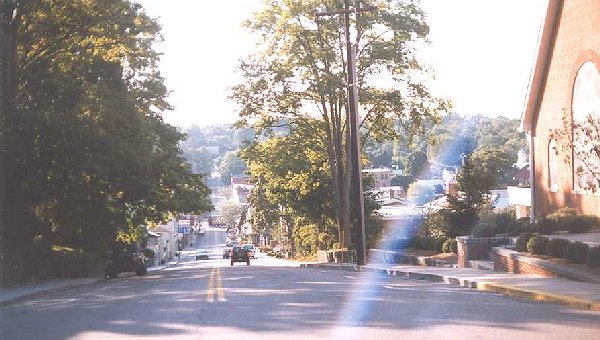
From Confederate Side
This is the view down the hill defended by the Confederates
near the General Lewis Inn. As pressure from Union attacks increased,
Confederate troops resorted to rolling cannon balls down hill. As the
Confederate line collapsed, Union cavalry charged up the hill. Crook
feared that there were other Confederate troops nearby and did not pursue
far. After battle, Heth's men returned to the New River to continue
protecting the vital railroad bridge.
In late June, Crook raided toward the town of Union between
Lewisburg and Giles CH, but both the Union and Confederate sides took troops
away from the region that summer, with the Union troops participating in the
Antietam campaign. Gen. Loring took over command of Confederate forces in
the region and advanced down the New River all the way to Fayettesville, beyond
Raleigh CH, but the returning Yankees forced the rebels to pull back. Both
sides had learned the difficulties of supplying an army of any size in this area
- miles beyond river or railroad transportation. From now on, raids would be used
instead. In May 1864, Crook would reach the railroad bridge at Central
Depot, after defeating a Confederate force at Cloyds Mountain. He
would further distinguished himself in the '64 Valley Campaign, and after the war came
to head the whole army.
See also:
Gray
Forces Defeated in Battle of Lewisburg A more detailed account.
topo
map The Union position was around Church Street. The Confederate
line was along Holt Lane.
Back
to Civil War Virtual Battlefield Tours









